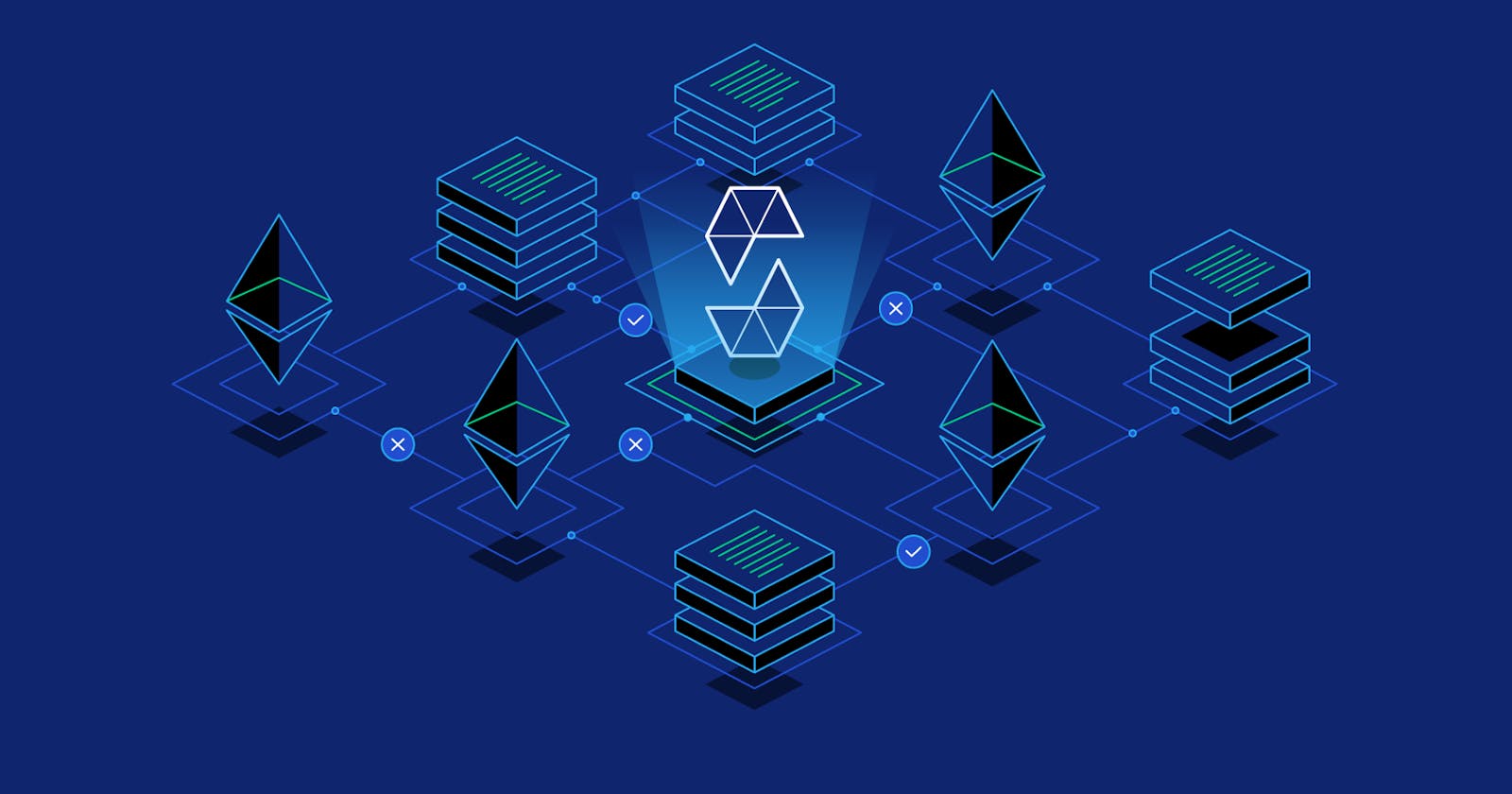Getting Started with Solidity: A Comprehensive Guide
Unlock the Secret to Building Your Apps with Solidity Programming! Learn How This Language is Taking the Tech World by Storm
Table of contents
- Get Started with Solidity Programming: A Guide to Setting Up Your Development Environment
Do you want to develop your own apps? Then you should learn about the Solidity programming language! Solidity is a programming language used to create applications for the Ethereum blockchain. It's similar to the "magic spell" that allows developers to bring their concepts to life.

You can use Solidity to create smart contracts, which are self-executing agreements that follow the rules and regulations you specify. Consider creating your virtual store or designing your own game with your own set of rules. The options are limitless!
But that's not all! Solidity is also used in industries such as finance, supply chain management, and even voting systems. It's a hot topic in the tech world and knowing how to use it could open up doors for your future career.
So, what are you waiting for? Join the Solidity revolution and start building your own apps today!
Get Started with Solidity Programming: A Guide to Setting Up Your Development Environment
Are you prepared to wade into the world of Solidity programming? Then it's time to get your development environment up and running! A development environment is a workspace where Solidity code can be written and tested. It's necessary for any programmer and the first step toward creating amazing blockchain applications.
In this article, we'll walk you through the process of creating a Solidity development environment. This guide will help you get started, whether you're a beginner or have some experience.
Here's what you'll need:
A computer: To run the development environment, you'll need a laptop or desktop computer.
A text editor will be required to write your Solidity code. Visual Studio Code, Sublime Text, and Atom are some popular options.
The Solidity compiler: The Solidity compiler is a tool that converts Solidity code into bytecode, which the Ethereum Virtual Machine understands.
A blockchain network: To test your Solidity code, you'll need a blockchain network. Use a local blockchain network, such as Ganache, or a test network, such as Rinkeby.
With these tools in hand, you can begin configuring your Solidity development environment.
Take the following steps:
Install your preferred text editor.
Install the Solidity compiler after downloading it.
Create a local blockchain network or join a test network.
In the text editor, write your Solidity code, and then use the compiler to convert it to bytecode.
Test your code on the blockchain network.
That's all! You are now prepared to begin developing your own Solidity applications.
Creating a Solidity development environment is a necessary step in learning how to build blockchain applications. You'll be on your way to becoming a Solidity programmer in no time if you have the right tools and a little bit of effort!
Become a Solidity Pro: Learn the Language's Fundamentals with Variables, Data Types, and More!
Are you ready to learn how to build apps with Solidity? Then it's time to learn the fundamentals of the language!

Solidity is a programming language used to create apps for the Ethereum blockchain. It, like any other language, has its own set of rules known as the syntax, as well as building blocks such as variables, data types, control structures, and functions.
Let us begin with variables. Variables are small containers that hold information such as your name or favorite color. Variables in Solidity can be used to store various types of information, such as numbers, text, or even more complex data.
Then there are data types. Consider data types to be different shapes, such as a circle or a square. Each shape serves a specific purpose, and the same is true for Solidity data types. For example, you could store text using a string data type and numbers using an integer data type.
Control structures and functions are also important Solidity building blocks. Control structures, such as if/else statements, assist you in controlling the flow of your code.
Functions, on the other hand, are like little helpers that perform specific tasks, such as adding two numbers.
By learning about these basic elements of Solidity, you'll be on your way to becoming a pro at creating blockchain apps. So, let's get started!
Here's an example of code that explains the basic elements of Solidity mentioned
pragma solidity ^0.8.17;
contract MyContract {
// Variables
string public myName;
uint256 public myAge;
// Data Types
function setName(string memory _name) public {
myName = _name;
}
function setAge(uint256 _age) public {
myAge = _age;
}
// Control Structures
function getGreeting() public view returns (string memory) {
if (myAge >= 18) {
return "Hello, " + myName + ". You are an adult.";
} else {
return "Hello, " + myName + ". You are a minor.";
}
}
// Functions
function addNumbers(uint256 a, uint256 b) public pure returns (uint256) {
return a + b;
}
}
We've defined a contract called "MyContract" in this code. Within the contract, we have two variables of type string and uint256, respectively. We also have two functions to set the values of these variables, setName and setAge.
The getGreeting function returns a different greeting based on the value of myAge using an if/else control structure.
Finally, the addNumbers function is a straightforward function that takes two arguments and returns the sum of their sums.
This code demonstrates how variables, data types, control structures, and functions operate in Solidity. Obviously, this is only the tip of the iceberg! There's a lot more to learn, but with a firm grasp of the fundamentals, you'll be well on your way to developing amazing blockchain apps.
Examples of smart contracts written and deployed on the Ethereum network.
Are you eager to learn more about smart contracts? Let's look at some real-life examples!
A smart contract is a self-executing program that lives on the Ethereum network and can store and transfer digital assets. They're like digital rules that make sure everyone follows the same agreement.
Here are two simple examples of smart contracts that you can write and deploy on the Ethereum network:
- Token Contract: This contract allows you to create your own digital token. You can specify the total number of tokens you want to create and the rules for transferring them between accounts.
pragma solidity ^0.8.17;
contract MyToken {
// Variables
string public name;
string public symbol;
uint256 public totalSupply;
mapping (address => uint256) public balances;
// Events
event Transfer(address indexed from, address indexed to, uint256 value);
// Constructor
constructor(string memory _name, string memory _symbol, uint256 _totalSupply) public {
name = _name;
symbol = _symbol;
totalSupply = _totalSupply;
balances[msg.sender] = _totalSupply;
}
// Functions
function transfer(address _to, uint256 _value) public {
require(balances[msg.sender] >= _value, "Not enough balance");
require(balances[_to] + _value >= balances[_to], "Overflow");
balances[msg.sender] -= _value;
balances[_to] += _value;
emit Transfer(msg.sender, _to, _value);
}
}
This code generates the token contract MyToken. It has three variables: name, symbol, and totalSupply, which allow you to specify your token's name, symbol, and total number of tokens. It also has a mapping, balances, which stores each account's balance.
When the contract is first deployed, the constructor function is called, allowing you to set the initial values for the name, symbol, and totalSupply variables. The balances mapping is also initiated, with the deploying account's balance set to totalSupply.
You can transfer tokens from one account to another using the transfer function. It verifies that the sender has sufficient balance to transfer and prevents overflow by ensuring that the recipient's balance plus the transfer value does not exceed the maximum value for an uint256 variable.
If the transfer is successful, a Transfer event is emitted to log the transfer. This is just a basic token contract example. There are numerous methods for creating and customizing token contracts, so feel free to experiment!
- Auction Contract: This contract allows you to run an auction. You can specify the starting price, bidding rules, and the end time of the auction. When the auction ends, the highest bidder wins and the bid amount is transferred to the seller.
pragma solidity ^0.8.17;
contract Auction {
// Variables
uint256 public startPrice;
uint256 public biddingIncrement;
uint256 public currentPrice;
address public highestBidder;
uint256 public auctionEndTime;
address public seller;
bool public auctionEnded;
// Events
event NewBid(address bidder, uint256 bid);
event AuctionEnded(address winner, uint256 finalPrice);
// Constructor
constructor(uint256 _startPrice, uint256 _biddingIncrement, uint256 _auctionEndTime, address _seller) public {
startPrice = _startPrice;
biddingIncrement = _biddingIncrement;
currentPrice = _startPrice;
auctionEndTime = _auctionEndTime;
seller = _seller;
}
// Functions
function bid() public payable {
require(msg.value > currentPrice, "Bid must be higher than current price");
require(msg.value >= currentPrice + biddingIncrement, "Bid must be at least bidding increment higher than current price");
require(now <= auctionEndTime, "Auction has ended");
require(highestBidder != address(0), "Cannot bid after auction has ended");
highestBidder = msg.sender;
currentPrice = msg.value;
emit NewBid(msg.sender, msg.value);
}
function endAuction() public {
require(now >= auctionEndTime, "Auction has not ended yet");
require(highestBidder != address(0), "No bid received");
require(seller != address(0), "Seller not set");
require(highestBidder.transfer(currentPrice), "Transfer failed");
auctionEnded = true;
emit AuctionEnded(highestBidder, currentPrice);
}
}
This code creates an auction contract named Auction. There are six variables in this formula: startPrice, biddingIncrement, currentPrice, highestBidder, auctionEndTime, and seller. You can specify the starting price, bidding increment, current price, highest bidder, auction end time, and seller.
When the contract is first deployed, the constructor function is called, allowing you to set the initial values for the startPrice, biddingIncrement, auctionEndTime, and seller variables.
Bidders can use the bid function to place a bid on the auction. It ensures that the bid value is greater than or equal to the bidding increment, that the auction has not ended, and that there is no current winner. If the bid is successful, the variables currentPrice and highestBidder are updated.
The seller can use the endAuction function to end the auction and transfer the funds to the highest bidder. It verifies that the auction has ended, that at least one bid was placed, and that the seller has been determined. If the conditions are met, the currentPrice is transferred to the highestBidder and an AuctionEnded event is emitted to log the transfer. This is merely a basic example of an Auction contract
You must deploy your smart contract to the Ethereum network once it has been written. You can do this by using an Ethereum client, such as Geth or Parity. After you deploy your contract, it will remain on the network indefinitely and be accessible to anyone.
As you can see, smart contracts have a wide range of exciting uses. Whether you're creating a digital token or holding an auction, the Ethereum network's power ensures that the rules are always followed. Prepare to begin exploring this amazing world!
Writing smart contracts, on the other hand, is a big responsibility because you have to make sure they're safe and efficient.
Here are some pointers to get you started:
Use a reputable programming language: Smart contracts require the use of a specific programming language. Choose one that is well-known and trusted in the blockchain community.
Test your contracts: Before making your contract public, make sure you thoroughly test it to ensure that it works properly and that there are no bugs or vulnerabilities.
Consider security risks: Smart contracts, like anything else on the internet, are vulnerable to hacking and other security threats. When writing your contract, keep these risks in mind and try to include security measures to mitigate them.
Be efficient: Smart contracts run on the blockchain, so it's critical that they don't take up too much space or slow down the network. Keep your code as simple as possible, and try to limit the amount of data your contract must process.
Adhere to best practices: There are numerous best practices for writing smart contracts, such as encryption and adhering to certain coding standards. Conduct some research and ensure that you are adhering to these guidelines to help keep your contracts safe and secure. You'll be well on your way to writing smart contracts that are both safe and efficient if you follow these guidelines!
Conclusion
Finally, smart contracts on the Ethereum network are transforming the world of decentralized transactions. The possibilities are endless, from creating your own digital tokens to holding an auction. You can bring your ideas to life and join the exciting world of blockchain technology by using Solidity as your programming language. Prepare to take your first step toward a decentralized future where trust and transparency are central to every transaction!
"Are you prepared to become a smart contract master? Follow me for expert advice and the most up-to-date information on creating secure and efficient contracts.
